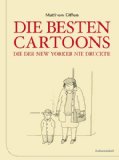Analyse a cartoon - "racism"

Racism
The Punch cartoon by “Nick” published in 1981 deals with the problem of inofficial discrimination out of racist motivations.
The place where the scene is placed is an office of an agency. In the foreground the back of a half-balded businessman with glasses can be seen. He sits in an armchair, surrounded by three telephones, they stand on his desk in front of him. It is obvious that this man has an important position in that agency, because he wears a suit and has many connections to the world through his three (!) telephones. This person leaves a very busy impression. He talks to a man, who stands in front of his desk. The second man has black coloured skin, so he seems so be an African. He wears a Superman costume. Although he takes a self-confident pose his facial expression shows disappointment and doupt.
The text beneath the cartoon makes the scene understandably: “ I'm sorry- we were really looking for someone who can't fly.” These are the words of the businessman, his answer to the application of the African. It is clear that this is a lie. Who else would be more qualified for the role of Superman than an actor, who indeed is able to fly? The qualification of the actor would be perfect if – and this is what the cartoonist is intending to show – he were not black. The confirmation (“really”) gives his words an ironic touch, so the lie and the discrimination get a brutal taste of racism.
The facial expression of the actor gives a hint to his knowledge of the brazen lie and with that to his awareness of the true reasons for the agency's refusal. The racism is covered by the expertly lie of the businessman, so the actor can not defend himself officially. He is helpless, subjected to inofficial, but very direct racism.
Out of my own experiences, I know, the cartoonist's expression of reality is right. Prejudices, Xenophobia and hate towards people of other races is an actual and horrible problem. For example, there are people in Germany, who do not accept black doctors to operate them because they are afraid of cannibalism (!). Furthermore the results of the latest elections in Germany should alarm everybody, who understand, what national socialism and racism means in its consequences. As technology brings the peoples of the world closer together and political barriers tumble, racial discrimination, xenophobia and other forms of intolerance continue to ravage our societies. Horrors such as "ethnic cleansing" have emerged in recent years, while ideas of racial superiority have spread to new media like the Internet. Even globalization carries risks that can lead to exclusion and increased inequality, very often along racial and ethnic lines. Irrespective of its sources or reasons, racism is racism. Ignorance is no excuse. Insecurity is not justification – racism in all its forms should be uncompromisingly condemned.
702 words
Inhalt
Aufgabe: Analysiere eine Karikatur zum Thema "Rassismus". Die Karikatur war vorgegeben. Ich konnte leider keine digitale Version auftreiben, aber mit der Beschreibung und der Analyse könnt ihr sicher was anfangen. (706 Wörter)
Hochgeladen
von unbekannt
Schlagwörter
Optionen
0 weitere Dokumente zum Thema "Werke"
285 Diskussionen zum Thema im Forum
285 Diskussionen zum Thema im Forum
- Cartoon Analyse (1 Antworten)
- American Dream: Cartoon - describe & analyse (1 Antworten)
- Ausdrucksvermögen und Rechtschreibung (5 Antworten)
- analyse - cartoon (3 Antworten)
- Cartoon analysieren? Global Warming? (3 Antworten)
- mehr ...
Wenn du dieses Dokument verwendest, zitiere es bitte als: "Analyse a cartoon - "racism"", https://e-hausaufgaben.de/Hausaufgaben/D2064-Racism-Analyse-a-cartoon-racism.php, Abgerufen 05.01.2026 11:21 Uhr
Es handelt sich hier um einen fremden, nutzergenerierten Inhalt für den keine Haftung übernommen wird.
Es handelt sich hier um einen fremden, nutzergenerierten Inhalt für den keine Haftung übernommen wird.
PASSENDE FRAGEN:
- Cartoon AnalyseKann mir bitte jemand eine gute Cartoon Analyse für diesen Cartoon schreiben ? Hab wirklich kein ideen :( Das ist unser ..
- American Dream: Cartoon - describe & analyseHallo zusammen, wir haben die Aufgabe bekommen folgenden Cartoon im Hinblick auf den American Dream zu beschreiben und zu ..
- Ausdrucksvermögen und RechtschreibungHey Leute ich werde am Freitag ein Referat vorstellen, mein thema ist über Rassismus. Es ist natürlich auhc wichitg bei meinem ..
- analyse - cartoonhey leute, ich soll einen cartoon analysieren. wie fange ich im englischen am besten damit an? (z.B. der mir vorliegende..
- Cartoon analysieren? Global Warming?Ich sollte diesen Cartoon analysieren...:http://www.cartoonstock.com/newscartoons/cartoonists/cbo/lowres/cbon88l.jpg Dies ..
- mehr ...
